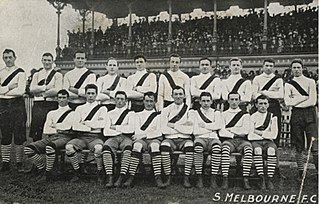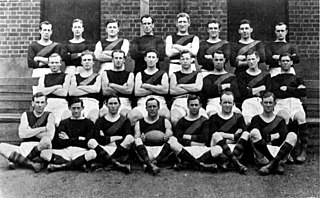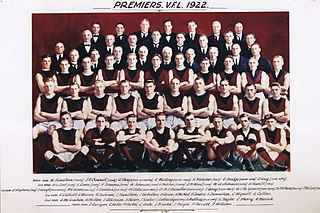
The 1901 VFL season was the fifth season of the Victorian Football League (VFL), the highest level senior Australian rules football competition in Victoria. The season featured eight clubs, ran from 4 May until 7 September, and comprised a 17-game home-and-away season followed by a finals series featuring the top four clubs.

The 1907 VFL season was the eleventh season of the Victorian Football League (VFL), the highest level senior Australian rules football competition in Victoria. The season featured eight clubs, ran from 27 April until 21 September, and comprised a 17-game home-and-away season followed by a finals series featuring the top four clubs.
Douglas Graeme Wade is a former Australian rules footballer who played for the Geelong Football Club and North Melbourne Football Club in the Victorian Football League (VFL).
Rivalries in the Australian Football League exist between many teams, most of which typically draw large crowds and interest regardless of both teams' positions on the ladder. The AFL encourages the building of such rivalries, as a method of increasing publicity for the league, to the point of designating one round each year as "Rivalry Round" when many of these match-ups are held on the one weekend. Whilst some rivalries, such as between teams from adjacent areas, are still strong, the designation of an entire round of fixtures as a Rivalry Round is often criticised due to some arbitrary match-ups, or ignoring stronger and more recent rivalries.

The 1909 VFL season was the 13th season of the Victorian Football League (VFL), the highest level senior Australian rules football competition in Victoria. The season featured ten clubs, ran from 1 May until 2 October, and comprised an 18-game home-and-away season followed by a finals series featuring the top four clubs.

Richard Condon was an Australian rules footballer who played for Collingwood and Richmond in the Victorian Football Association (VFA) and the Victorian Football League (VFL) from 1894–1900, 1902–1906 and 1908–1909.

The 1920 VFL season was the 24th season of the Victorian Football League (VFL), the highest level senior Australian rules football competition in Victoria. The season featured nine clubs, ran from 1 May until 2 October, and comprised a 16-game home-and-away season followed by a finals series featuring the top four clubs.

The 1922 VFL season was the 26th season of the Victorian Football League (VFL), the highest level senior Australian rules football competition in Victoria. The season featured nine clubs, ran from 6 May until 14 October, and comprised a 16-game home-and-away season followed by a finals series featuring the top four clubs.
The 1928 VFL season was the 32nd season of the Victorian Football League (VFL), the highest level senior Australian rules football competition in Victoria. The season featured twelve clubs, ran from 21 April until 29 September, and comprised an 18-game home-and-away season followed by a finals series featuring the top four clubs.

The 1929 VFL season was the 33rd season of the Victorian Football League (VFL), the highest level senior Australian rules football competition in Victoria. The season featured twelve clubs, ran from 27 April until 28 September, and comprised an 18-game home-and-away season followed by a finals series featuring the top four clubs.

The 1931 VFL season was the 35th season of the Victorian Football League (VFL), the highest level senior Australian rules football competition in Victoria. The season featured twelve clubs, ran from 2 May until 10 October, and comprised an 18-game home-and-away season followed by a finals series featuring the top four clubs.

The 1934 VFL season was the 38th season of the Victorian Football League (VFL), the highest level senior Australian rules football competition in Victoria. The season featured twelve clubs, ran from 5 May until 13 October, and comprised an 18-game home-and-away season followed by a finals series featuring the top four clubs.

The 1937 VFL season was the 41st season of the Victorian Football League (VFL), the highest level senior Australian rules football competition in Victoria. The season featured twelve clubs, ran from 24 April until 25 September, and comprised an 18-game home-and-away season followed by a finals series featuring the top four clubs.
The 1967 VFL season was the 71st season of the Victorian Football League (VFL), the highest level senior Australian rules football competition in Victoria. The season featured twelve clubs, ran from 15 April until 23 September, and comprised an 18-game home-and-away season followed by a finals series featuring the top four clubs.
The 1969 VFL season was the 73rd season of the Victorian Football League (VFL), the highest level senior Australian rules football competition in Victoria. The season featured twelve clubs, ran from 5 April until 27 September, and comprised a 20-game home-and-away season followed by a finals series featuring the top four clubs.
The 1972 VFL season was the 76th season of the Victorian Football League (VFL), the highest level senior Australian rules football competition in Victoria. The season featured twelve clubs, ran from 1 April until 7 October, and comprised a 22-game home-and-away season followed by a finals series featuring the top five clubs – an increase from the four clubs which had contested the finals in previous years.
Desmond Vincent Tuddenham is a former Australian rules footballer who played for Collingwood and Essendon in the Victorian Football League (VFL) during the 1960s and 1970s.
Peter Pianto was an Australian rules footballer who played for the Geelong Football Club in the Victorian Football League (VFL) and the Claremont Football Club in the West Australian National Football League (WANFL) and later coached Geelong, replacing teammate Bob Davis.
The 1930 VFL Grand Final was an Australian rules football game contested between the Collingwood Football Club and Geelong Football Club, held at the Melbourne Cricket Ground in Melbourne on 11 October 1930. It was the 32nd annual Grand Final of the Victorian Football League, staged to determine the premiers for the 1930 VFL season. The match, attended by 45,022 spectators, was won by Collingwood by a margin of 30 points, marking that club's ninth premiership victory and fourth in succession. As of 2022, Collingwood is the only team in VFL/AFL history to win 4 consecutive premiersips.
The 1937 VFL Grand Final was an Australian rules football game contested between the Geelong Football Club and Collingwood Football Club, held at the Melbourne Cricket Ground in Melbourne on 25 September 1937. It was the 39th annual grand final of the Victorian Football League, staged to determine the premiers for the 1937 VFL season. The match, attended by a then-record crowd of 88,540 spectators, was won by Geelong by a margin of 32 points, marking that club's third premiership victory and first since winning the 1931 VFL Grand Final.









